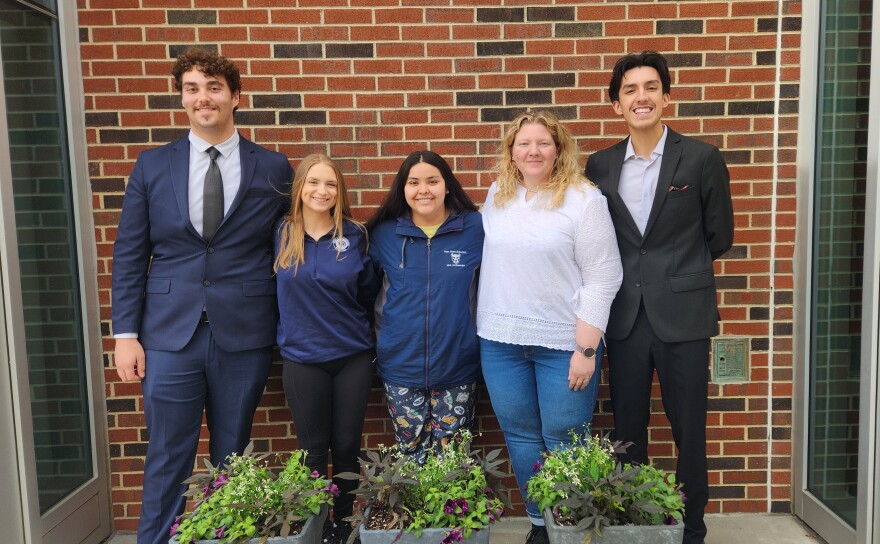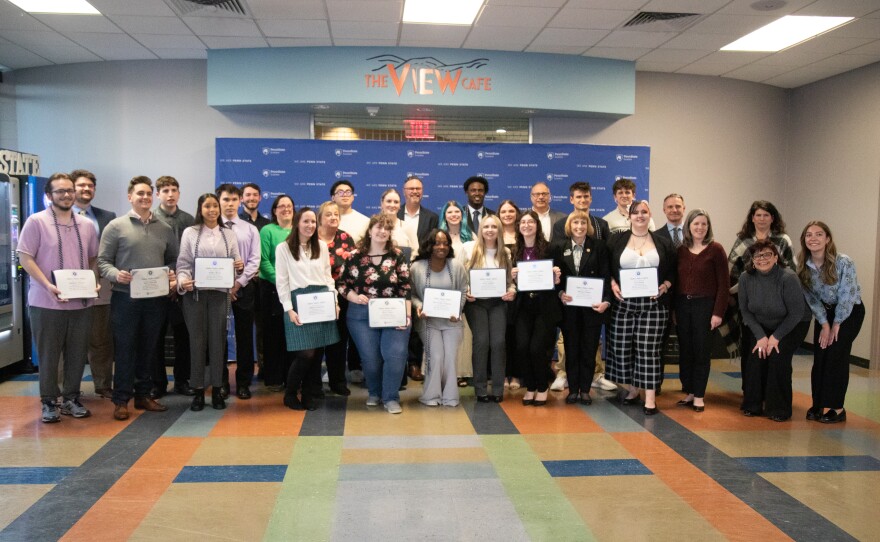Across regional Penn State campuses, students prepare for final exams. Flowers bloom as commencement nears. Fear, anxiety and hope persist.
University leadership announced in February that some Commonwealth campuses would likely close in two years, citing growing financial uncertainty and declining enrollment.
The seven largest campuses — Abington, Altoona, Behrend, Berks, Brandywine, Harrisburg and Lehigh Valley — will remain open. The future of the 12 remaining campuses, including Hazleton, Schuylkill, Scranton and Wilkes-Barre, will be decided by a university committee. President Neeli Bendapudi said this month that the announcement will likely come in mid-May. The campuses would close after the 2026-27 academic year.

The news of possible closures shook the campuses. Students organized rallies and reached out to state legislators and university leaders. Business owners, elected officials and alumni mobilized around each school, highlighting economic impact and Penn State’s land-grant mission.
That mission emphasizes accessibility in higher education, ensuring that a four-year degree is within reach for individuals from all backgrounds. Without local campuses, advocates argue fewer students would have the chance to pursue higher education.
Enrollment in the 19 Commonwealth campuses, which does not include University Park, has declined by about 24% over the last decade. That number is greater in the Northeast.
Since 2014, enrollment has shrunk a combined 28.6% in Hazleton, Schuylkill, Scranton and Wilkes-Barre. Compared to 20 years ago, enrollment has declined by 43.8% at the four campuses.
In 2014, 4,216 students attended the four locations. As of the fall, 2,369 students were enrolled. Overall, college enrollment is down at schools nationwide as demographics shift and not as many students pursue college degrees.
Penn State shrunk its workforce and raised tuition to deal with shortfalls. State funding has failed to keep up with rising costs. In 1970, state appropriations made up 62% of Penn State’s education budget. Now, it’s 10%, according to the university.

Elizabeth Wright became regional chancellor in summer 2024, overseeing the Hazleton, Scranton and Wilkes-Barre campuses. Enrollment at Hazleton and Wilkes-Barre have declined by more than 50% on each campus in the last 20 years.
“This is a hard time for our faculty, our staff and our students,” Wright said. “There's a lot of uncertainty. No decisions have been made. We know that we'll be open for two years at each of these campuses at a minimum, but at the same time, we're really resolved that regardless of what happens, as President Bendapudi has said, there will be a presence in the Northeast.”
That presence could include merging campuses. Campus leaders have spent the last two months highlighting their unique programs and impact.
“We are special for this community because we are the only four-year degree program. And then when you look at our programs, our nursing program is desperately needed here,” said Cory Scherer, interim chancellor of the Schuylkill campus. “We think that we have a very strong case to stay open.”

At a student-led rally in Hazleton this month, students fought tears as they explained why the campus known as “Highacres” helps elevate their lives. In Schuylkill County, students questioned where they’d attend college if the campus shutters. Some students can't afford housing or don't have the means to commute to a campus farther away. In Scranton and Wilkes-Barre, students talked about the impact of receiving a Penn State education close to home.
WVIA News spent time on the region’s four campuses and learned how each is unique, the impact they have in the community and what could be lost if they close.
Research in Hazleton
Penn State Hazleton
Fall 2024 enrollment: 515
20-year difference: -53.8%
5-year difference: -16.8%
Research posters hang in the lower level of the Lofstrom Library. Students refer to their notecards as they practice their presentations. It’s the annual campus Undergraduate Research Symposium, and judging begins in one hour.
Junior Matthew Greenfield and his team helped determine the sex of brook trout from Cooks Run in Clinton County. With the presence of acid mine drainage in the Susquehanna River Basin, the team gathered data that can provide insight into the health of the ecosystem.

“This has been a wonderful experience for me,” the Lehighton native said. “This has been a very great educational tool for me, and it's offered me fantastic perspective on the value of the work that goes on here."
Megan Schall’s Biology 110 class inspired Greenfield. Freshman Marinna Mazzocca, a biology major from Tamaqua, found inspiration too.
Mazzocca’s research used molecular techniques to identify possible hosts for fish parasites in the Susquehanna River Basin. Her team extracted DNA from snails and worms and sequenced the samples.
“We have smallmouth bass that are really important economically and ecologically, and there's some parasites that can affect them, and then other fish in the ecosystem,” she said.
When Schall, an associate professor of biology, started at the Hazleton campus eight years ago, she made it a goal to have her students be part of her research.
“They have exceeded my expectations every semester, and I'm just so proud of the way they speak and present their work and how excited they are,” she said.
Students said the small class sizes allow them to form relationships with faculty members and to conduct hands-on research, even as freshmen.
“My mind was blown when I came to this campus, because I'm a first-generation student and an adult student, so I had no idea what kind of opportunities I was going to get,” Mazzocca said.
Penn State education came to Hazleton in the depths of the Great Depression. City leaders requested more educational opportunities for the immigrant community. The Hazleton Undergraduate Center opened in 1934 with 47 full-time and 60 part-time evening students. It moved to its Sugarloaf Twp. location in 1948.

During an event with lawmakers this month, supporters highlighted the potential growth for the school. Population in the city of Hazleton jumped nearly 20% since 2010, according to U.S. Census estimates from 2023. Of all Commonwealth campuses, Hazleton students have the greatest financial need, Wright said.
If Hazleton is on the list to close, Greenfield would still be able to complete his degree there. The campus would close after Mazzocca’s junior year.
“It's really nerve-wracking right now, because it's hard to plan anything, and especially for someone like me,” she said. “It's not really viable for me to go to another campus because I commute. I also still work part-time. I've got a lot of moving parts.”

Future job training in Schuylkill
Penn State Schuylkill
Fall 2024 enrollment: 698
20-year difference: -28%
5-year difference: +10.6%
Alejandro Serrano learns lessons in the classroom and at businesses in the community. The second-year business management student from Pottsville is enrolled in the campus’ co-op program.
“The co-op experience for me has been extremely crucial to me coming to Penn State,” he said. “It was the exact reason that I chose this campus, because I knew how important it was to get work experience and understand those skills beyond just learning in the classroom."
The Schuylkill campus started its co-op program in 2020. Five years later, about 50% of students — other than those in programs with clinical requirements — participate in internships and placements.

“As soon as they come as a first year, we are building a resume for them so that when they graduate at the end of the fourth year, they don't only just have a graduation and a diploma, they also have all of the soft skills that you'd hope that someone would have, so they'd be job ready,” said interim Chancellor Cory Scherer.
The program, unique to the Schuylkill campus, has become so successful that leaders are now working with other campuses to implement co-ops across the state.
The program includes paid internships and six months of on-the-job training. In accompanying one-credit classes, students learn interview skills, how to work as a team and how to create a LinkedIn profile. The campus partners with more than 100 area employers for placements.
The campus, located in North Manheim Twp., is the only of the 19 to see enrollment increase since 2020 — a fact Scherer partly credits to the co-op program. The school traces its origins to the 1930s, when a group of Pottsville citizens sought local, affordable, post-secondary education.
As daffodils began to bloom and a grounds crew spread fresh mulch, a few students gathered outside in the shade of a picnic table umbrella.

Arabi Chavira, a fourth-year biology major from Oklahoma, was drawn to the Schuylkill campus because of the “Big Ten name” and community feel. She spent three years interning with the Schuylkill County Coroner's Office — which helped her confirm her career choice of forensic pathology.
“I got to experience so much more than I would have just being in college by itself,” she said.
Sierra Wishnefsky, a third-year psychology major from Ringtown, learned about trauma therapy as an intern.
“The internships in general really helped shape my college career, because they solidified job opportunities, networking,” she said. “I was able to apply what I was learning in class into the real world, rather than four years later.”
For Renee Paetzell, a student from Minersville, an internship helped ensure she didn’t pursue the wrong career. She went from health policy administration to human resources.
“Getting first-hand experience, then knowing that's not really what I wanted, and being able to shift into what I wanted to do that I was more passionate about was incredible,” she said.
Sophomore Carter Strouse became a licensed insurance agent through his internship.
“You're going to graduate and you're going to have a job, you're going to have a resume,” he said.

First-generation support in Scranton
Penn State Scranton
Fall 2024 enrollment: 827
20-year difference: -38.9%
5-year difference: -15.2%
When Ashey Reyes enrolled at Penn State Scranton, she couldn’t rely on her family for first-hand advice about what to expect.
Like nearly half of the students at the school in Dunmore, Reyes is a first-generation student, meaning the first in her family to attend college.
“Learning that we can go to our professors, and it's not like a crazy thing… and that they're willing and able to answer any questions we have, is just amazing,” said the Scranton resident, who will graduate next month with a degree in information technology application development.

Reyes was one of 20 students this month to be inducted into the campus’ new chapter of Alpha Alpha Alpha, an honor society for first-generation students.
Students and their families enjoyed dinner and posed for photos, as a sunset over West Mountain cast a warm glow in the Sherbine Lounge.

Louis Ingargiola is a past president of the campus’ advisory board. He’s also a first-generation college graduate, and he shared some wisdom with the students during the ceremony.
“The road to higher education is rarely easy. It often involves balancing academic work responsibilities with family commitments and navigating the complexities of college life," he said. "But through dedication and hard work, we have proven that these obstacles do not confine us. Instead, they shape us into stronger individuals."
The Scranton campus, now located in Dunmore, started offering evening technical programs in 1923. The school contributes more than $40 million annually to the state’s economy, according to the campus.

Of the four regional campuses, Scranton is the largest. A new engineering building opened in 2022, and the school renovated the library and nursing suite and unveiled it last year. Like the other campuses, students can receive the first two years of more than 275 different Penn State majors, before heading to University Park.
Penn State offers resources, including academic coaching and advising, that are especially helpful for first-generation students.
When John Matthew Evans began his studies, he sometimes found himself questioning whether he was doing what he needed to do. The senior nursing major from Blakely became part of the honor society that night and reflected on his time on the Scranton campus.
“I still got to experience Penn State, but in this smaller, intimate setting. I got to be with a smaller class, and a lot of them will become lifelong friends," Evans said. "The professors know each student individually, so if you ever have a problem, you can go to them.”
Expanding boundaries in Wilkes-Barre
Penn State Wilkes-Barre
Fall 2024 enrollment: 329
20-year difference: -57.8%
5-year difference: -22.4%
Sun reflected off the surveying prism in the yard outside the Bell Center for Technology.
Seniors Lucas Carpenter, from Tunkhannock, and Nathan Crotts, from Bucks County, demonstrated some of the equipment land surveyors use in the field.
The campus in Lehman Twp. is the only in the state to offer a four-year surveying degree. It’s one of only six locations in the country that offer an engineering degree that combines surveying, geomatics and geospatial studies.
The potential closure of the campus comes at a time of greater demand for surveyors. The average age of a surveyor is 58, which means that in less than 10 years, nearly half of the surveyors now employed will be retiring, according to the Pennsylvania Society of Land Surveyors. The association regularly works with the program, providing professional development opportunities and connections with employers.

“This is the future of the profession,” Crotts said. “Every surveyor coming into the state is coming out of here.”
The campus can trace its origins back to surveying and engineering. Its founding in 1916 makes it the oldest higher education presence in the Wyoming Valley. The local anthracite mining industry needed to improve mining methods and worker safety. The Penn State Department of Engineering Extension began offering evening classes for 150 students in the former Coughlin High School. The new program offered courses in advanced mathematics, surveying, reinforced concrete and mechanics.
A combined 31 students are now enrolled in the associate and bachelor’s degree surveying programs.
“Looking at the numbers with the Pennsylvania Society of Land Surveyors, we've made an estimate that we in Pennsylvania will probably need about 50 or 60 surveyors graduating every year to replace those numbers,” said Dimitrios Bolkas, associate professor and program coordinator. “We graduate with a pace of, let's say five to 10 surveyors every year…there is way more room for more students to go into the profession.”
Bolkas says the public often doesn’t know what surveyors do.
“Any kind of, let's say construction, any kind of land development, any kind of residential development, they will need some sort of assistance from a surveyor,” he said.

Beyond finding boundaries, surveyors create maps and models. Program lecturer Matthew Sharr graduated from the program in 2014. He later completed hydrographic surveys in the Arctic and southeast Alaska, mapping the ocean.
As a student more than a decade ago, the enrollment in the program was about double what it is now. Enrollment across campus has declined by 40% over the last 10 years.
The students don’t want to see the campus close. With 329 students, the campus is the second smallest in the state system. Shenango, in Mercer County, is the smallest. If Wilkes-Barre closes, the surveying profession needs the program to continue elsewhere.
“We're pretty good at adapting, and, you know, wherever they put us, I think we're just going to make the best of it,” said Carpenter, who will work as a survey technician after graduation. “We have the support of every surveyor in the state… we have a lot of people backing us.”












